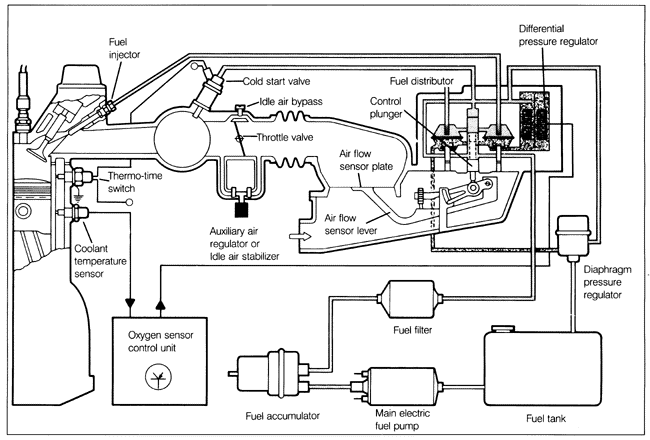6. CIS-Electronic (CIS-E) and CIS-E Motronic

Fig. 6-1 is a schematic view of CIS-E fuel injection. Much like the simpler CIS fuel injection described earlier, the basic fuel metering functions of CIS-E and CIS-E Motronic are mechanical. Like CIS, these systems sense air flow mechanically and manipulate fuel pressure to control fuel delivery to the injectors. Like CIS, these are continuous systems-the injectors deliver fuel continuously-they do not open and close to control fuel delivery. The main function of the fuel injectors is to atomize the flow of fuel being supplied under pressure from the fuel distributor. CIS-E differs from the earlier CIS system in that it has additional electronic controls to more precisely regulate fuel pressures and control fuel mixture. CIS-E Motronic is a complete engine management system, fully integrating electronic control of CIS-E fuel injection, ignition, evaporative emissions, and idle speed. The heart of CIS-E fuel injection is the mixture control unit-the air flow sensor and the fuel distributor. Air entering the engine raises the air flow sensor plate. A lever connected to the sensor plate raises the control plunger in the fuel distributor, increasing the quantity of fuel flowing to the injectors in proportion to the air flow. The differential pressure regulator makes additional fine adjustments to fuel delivery based on inputs from various sensors. By regulating electric current flow in the differential pressure regulator circuit, fuel pressure in the lower chamber of the fuel distributor is varied to control the amount of fuel delivered to the injectors. The cold start valve, the auxiliary air regulator or idle air stabilizer, and the air flow sensor plate potentiometer (not shown in Fig. 6-1) also help adapt the system to different operating conditions. The cold-start valve is like a fifth injector, serving a function much like that of a choke on a carburetor. It injects additional fuel into the intake manifold during starting to provide a richer fuel mixture when the engine is cold. The cold-start valve is operated electrically. The auxiliary air regulator opens when the engine is cold to allow a small amount of air to bypass the throttle plate and boost the idle speed. On some models, the auxiliary air regulator is replaced by a more sophisticated idle air stabilizer which is operated directly by the control unit and maintains a constant idle speed under all conditions. The air flow sensor plate potentiometer is a sensor which provides the control unit with a signal indicating sensor plate position. On CIS-E systems, the signal is used by the control unit for cold acceleration enrichment. On CIS-E Motronic, the potentiometer is used to provide the control unit with an indication of engine load.
Many of the CIS-E electrical components can be tested using only a low-current LED test light and a multimeter, but the basic fuel metering system is also highly dependent on accurate control of fuel pressure. Testing the system's basic fuel metering functions requires a fuel pressure gauge. See 6.6 Fuel Pressure Tests and Specifications for more information. |